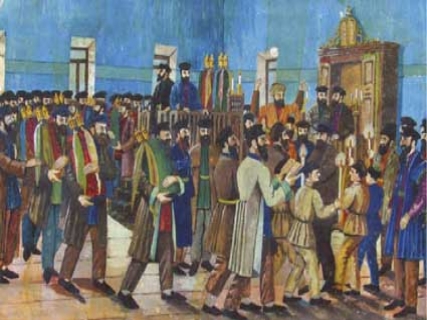Shalom Koboshvili on:
[Wikipedia]
[Google]
[Amazon]
 Shalom Koboshvili (1876 – 1941) was a
Shalom Koboshvili (1876 – 1941) was a
 Shalom Koboshvili (1876 – 1941) was a
Shalom Koboshvili (1876 – 1941) was a Georgia
Georgia most commonly refers to:
* Georgia (country), a country in the South Caucasus
* Georgia (U.S. state), a state in the southeastern United States
Georgia may also refer to:
People and fictional characters
* Georgia (name), a list of pe ...
n artist
An artist is a person engaged in an activity related to creating art, practicing the arts, or demonstrating the work of art. The most common usage (in both everyday speech and academic discourse) refers to a practitioner in the visual arts o ...
who specialised in drawings and paintings of Jewish life in Georgia. Born to a poor family of Jews in Akhaltsikhe, Koboshvili was originally intended for the Rabbi
A rabbi (; ) is a spiritual leader or religious teacher in Judaism. One becomes a rabbi by being ordained by another rabbi—known as ''semikha''—following a course of study of Jewish history and texts such as the Talmud. The basic form of t ...
nate, but quit religious training at an early age. His interest in art was discouraged by his family, and he was originally apprenticed as a printer. All his knowledge of art was effectively self-taught. After a varied career (in which around 1910 he is said to have met with the artist Niko Pirosmani
Nikoláy Aslánovich Pirosmanashvíli ( ka, ნიკოლოზ ფიროსმანაშვილი, Nik’oloz Phirosmanashvili) or Niko Pirosmani ( ka, ნიკო ფიროსმანი, Nik’o Pirosmani), Mononymous person, s ...
) he eventually became in 1937 a watchman at the newly established Jewish Historic-Ethnographic Museum in Tbilisi. His work there apparently inspired him to devote himself to painting and all his surviving work dates from the period 1937–1941, the year of his death.
Koboshvili's work, which is all in a competent but naive style, is entirely devoted to scenes of Jewish life; sometimes painted in oils, sometimes in water colours on paper. There are scenes relating to Jewish marriages, to Jewish festivals (including Sukkot
Sukkot, also known as the Feast of Tabernacles or Feast of Booths, is a Torah-commanded Jewish holiday celebrated for seven days, beginning on the 15th day of the month of Tishrei. It is one of the Three Pilgrimage Festivals on which Israelite ...
and Yom Kippur
Yom Kippur ( ; , ) is the holiest day of the year in Judaism. It occurs annually on the 10th of Tishrei, corresponding to a date in late September or early October.
For traditional Jewish people, it is primarily centered on atonement and ...
), and to scenes of Jewish life in Georgian villages and on Jewish kolkhoz
A kolkhoz ( rus, колхо́з, a=ru-kolkhoz.ogg, p=kɐlˈxos) was a form of collective farm in the Soviet Union. Kolkhozes existed along with state farms or sovkhoz. These were the two components of the socialized farm sector that began to eme ...
es.
The Georgian Jewish Museum was forcibly closed in the 1950s and its contents, including the works of Koboshvili, were transferred to the Georgian National Museum
The Georgian National Museum ( ka, საქართველოს ეროვნული მუზეუმი, tr) unifies several leading museums in Georgia.
The museum was established within the framework of structural, institutional, and ...
, to which they still belong. A retrospective exhibition of the works of Koboshvili was held at the Museum in Tbilisi in 2006.
See also
* Mayer KirshenblattNotes
References
{{DEFAULTSORT:Koboshvili, Shalom 1876 births 1941 deaths People from Akhaltsikhe Jewish artists 20th-century artists from Georgia (country) Modern painters Jews from Georgia (country) Artists from the Russian Empire 20th-century Jews from Georgia (country) 19th-century Jews from Georgia (country)